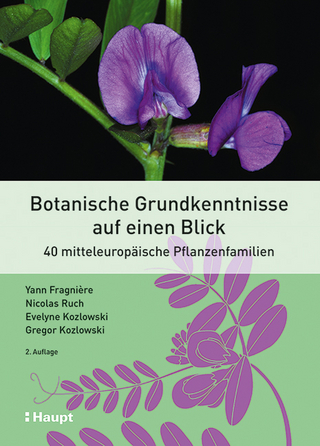
Plant Biodiversity
CABI Publishing (Verlag)
978-1-78064-694-7 (ISBN)
Results of regular monitoring of the species diversity and structure of plant communities is used by conservation biologists to help understand impacts of perturbations caused by humans and other environmental factors on ecosystems worldwide. Changes in plant communities can, for example, be a reflection of increased levels of pollution, a response to long-term climate change, or the result of shifts in land-use practices by the human population. This book presents a series of essays on the application of plant biodiversity monitoring and assessment to help prevent species extinction, ecosystem collapse, and solve problems in biodiversity conservation. It has been written by a large international team of researchers and uses case studies and examples from all over the world, and from a broad range of terrestrial and aquatic ecosystems. The book is aimed at any graduate students and researchers with a strong interest in plant biodiversity monitoring and assessment, plant community ecology, biodiversity conservation, and the environmental impacts of human activities on ecosystems.
Abid A. Ansari is with University of Tabuk, Saudi Arabia. Sarvajeet S. Gill is with MD University, India.
Part I: Plant Biodiversity – An Overview 1: New Challenges to Promote Botany’s Practice Using Botanic Gardens: The Case Study of the Lisbon Botanic Garden 2: New Horizons in Diversification of Temperate Fruit Crops 3: Asteraceae of India and its Diversity and Phytogeographical Affinity 4: Maintenance of Plant Species Diversity in Forest Ecosystems Part II: Plant Biodiversity and Ethnobotany 5: Plant Diversity of the Drylands in Southeast Anatolia-Turkey: Role in Human Health and Food Security 6: Observations on Some Ethnomedicinal Plants of Jharkhand Part III: Plant Biodiversity and Biochemical Parameters 7: Plant Diversity: Envisioning Untold Nanofactories for Biogenic Synthesis of Nanoparticles and Their Applications 8: Plant Diversity Repertoire of Bioactive Triterpenoids Part IV: Plant Biodiversity and Climatic Factors 9: Roles of Secondary Metabolites in Protection and Distribution of Terrestrial Plants under Climatic Stresses 10: Summer Semi-Deciduous Species of the Mediterranean Landscape: A Winning Strategy of Cistus Species to Face the Predicted Changes of the Mediterranean Climate Part V: Plant Biodiversity and Environmental Studies 11: Aquatic Plant Biodiversity: A Biological Indicator for Monitoring and Assessment of Water Quality 12: Gymnosperm Diversity of Kashmir Himalayas Part VI: Cross Talk between Plant and Microbial Biodiversity 13: Diversity of Plant Parasitic Nematodes in Pulses 14: The Influence of Soil Microbes on Plant Diversity 15: Plant Associated Endophytic Plethora: An Emerging Source of Antimicrobial Potentials Part VII: Plant Biodiversity: Monitoring and Assessment 16: Biodiversity, Bioindicators and Biogeography of Freshwater Algae 17: Quantitative Description of Upper Storey Vegetation at a Foothill Forest in Indian Eastern Himalayas 18: Significance of Permanent Sample Plots (PSPs) Established in Different Forest Ecosystems in Monitoring Ecological Attributes and Conservation of Biodiversity: A Review 19: Effects of Harvesting Plan on Tree Species Diversity: An Evaluation of Two Logged Forest Compartments 20: Diversity of Angiospermic Flora of West Bengal, India 21: Status of Invasive Plants in Tamil Nadu, India – Its Impacts and Significance 22: Patterns of Plant Endemism and Forest Regeneration Processes in Northern Western Ghats 23: DNA Barcoding as a Molecular Tool for the Assessment of Plant Biodiversity Part VIII: Plant Biodiversity: Conservation 24: Onion and Related Taxa: Ecogeographical Distribution and Genetic Resources in India 25: Traditional Ecological Knowledge and Plant Biodiversity Conservation in a European Transfrontier Landscape 26: Cryoconservation Methods for Extended Storage of Plant Genetic Resources 27: Interspecific Chemical Differentiation within the Genus Astragalus (Fabaceae) Based on Sequential Variability of Saponin Structures 28: Implementing Traditional Ecological Knowledge in Conservation Efforts 29: Conserving Forest Biodiversity 30: Invasive Alien Weed Species: A Threat to Plant Biodiversity
| Erscheinungsdatum | 30.12.2016 |
|---|---|
| Co-Autor | Maria Amélia Martins-Loução, Gisela Gaio-Oliveira, Mohammad Maqbool Mir |
| Zusatzinfo | 139 Illustrations, unspecified |
| Verlagsort | Wallingford |
| Sprache | englisch |
| Maße | 246 x 189 mm |
| Gewicht | 1952 g |
| Themenwelt | Naturwissenschaften ► Biologie ► Botanik |
| Naturwissenschaften ► Biologie ► Ökologie / Naturschutz | |
| ISBN-10 | 1-78064-694-1 / 1780646941 |
| ISBN-13 | 978-1-78064-694-7 / 9781780646947 |
| Zustand | Neuware |
| Haben Sie eine Frage zum Produkt? |
aus dem Bereich


